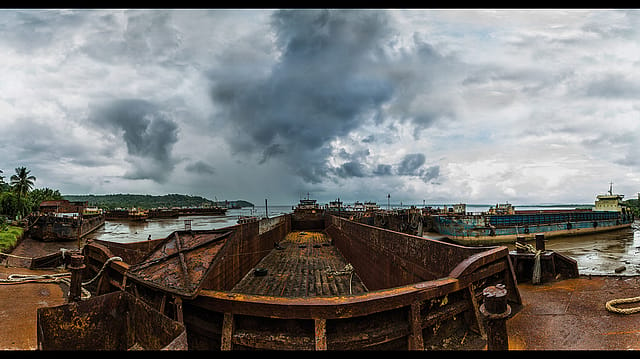The party is over, Goa
ADVERTISEMENT

Once upon a time, not so long ago, mining in Goa was a great business to be in. The golden age of mining began in January 2006, with a boom in export prices; exporters were making as much as $73.4 (Rs 4,637) per tonne. Global prices touched a record $187.1 per tonne in February 2011. The industry produced 45 million tonnes of ore annually. This upswing coincided with the boom in commodities fuelled by China’s astonishing growth.
But like all good things, this came to an abrupt end in September 2012, when the Supreme Court imposed a ban on iron ore mining in Goa after a judicial panel exposed a scam involving mining companies, bureaucrats, and politicians. This order marked the culmination of a campaign by environmental activists led by the Goa Foundation, which alleged that all 90 mines were illegal because they did not comply with wildlife conservation rules. (Mining is carried on in the area between the coast and the Western Ghats, protected by a series of contiguous national parks and wildlife sanctuaries.)
Before the ban, iron ore mining used to contribute around 25% to the state’s GDP. Around 150,000 people (35% of the state’s employable population) benefited from the mining industry ecosystem. For example, around 20,000 trucks owned by contractors, often employing drivers from outside the state, transported the ore to jetties. The ore was then loaded on 375 barges and taken to the ships at the Mormugao harbour, and from there, sent to China. Today several empty barges can be seen at the harbour.
December 2025
The annual Fortune 500 India list, the definitive compendium of corporate performance, is out. This year, the cumulative revenue of the Fortune 500 India companies has breached $2 trillion for the first time. Plus, find out which are the Best B-schools in India.
A report, The Goa Grant of Mining Leases Policy, 2014, pegged the loss during the period of the ban at $8 billion (when the ban was imposed in 2012, the price of ore was around $100 per tonne). It added that the ban had a cascading effect on the state’s economy, with small businesses such as automobile workshops, petrol pumps, consumer goods vendors, and roadside service stations suffering as much as the mining industry. The imbroglio has also made the state highly dependent on tourism for income generation.
The Supreme Court, in April 2014, lifted the ban, but put a cap of 20 million tonnes on annual production. This cap, imposed to curb excess and illegal mining, is preventing miners from achieving economies of scale. Also, during the years of the ban, medium-grade iron ore producers from Australia moved in to fill the void. Now, regaining the turf will be a tall order for Indian exporters. Dumping by low-cost producers such as Brazil and Australia has also hit Indian exports. The government protected the steel industry, which was facing a similar situation, by imposing a 20% safeguard duty, but the mining industry has been left to fend for itself. “All our demands have fallen on deaf ears,” says an industry official.
Soon after the ban was lifted, the central and state governments levied a number of taxes, which raised the tax rate to nearly 40%. However, corresponding tax rates in Brazil, China, South Korea, and Australia range from 0.7% to 7.5%. Some of these countries have also devalued their currency, further blunting the competitive edge of Indian miners. Which is why, two years after the court’s decision, there are hardly any signs of recovery.
To make matters worse, China is going through a bad period economically. Because of its poor quality, Goa’s iron ore can only be exported to China and cannot be used by the domestic steel industry, which requires a much higher grade of iron ore.
China, the biggest importer of Goa’s low-grade ore (iron content less than 57%) and the world’s largest producer of steel, is going though what economists see as the worst economic slowdown in 25 years. Its 6.9% growth in 2015 is unlikely to get any better this year. Demand from the rest of the world, too, has been suffering as countries are grappling with high debt, falling growth, lacklustre demand, and overcapacity.
In 2015, China’s steel production shrank 2.3%, the U.S.’s 10.5%, Ukraine’s 15.6%, and Japan’s 5%. Iron ore prices crashed from a high of $179.6 per tonne in January 2011 to $114.5 in April 2014 and is hovering around $30 per tonne now. It is expected to fall further ($20 a tonne, according to some analysts) given the overcapacity and the subdued market. Iron ore stockpiles in Chinese ports are close to 100 million tonnes.
In all this, the 375 barges that used to ply ore to and fro have been lying moored empty and rusting. The mining industry has asked the government to provide immediate relief in taxes and export duty so that operations can become viable again. But going by the tardy progress—bureaucrats are wary of taking decisions that may be seen to be favouring the industry—Goa’s iron ore mining industry may just rust away.
